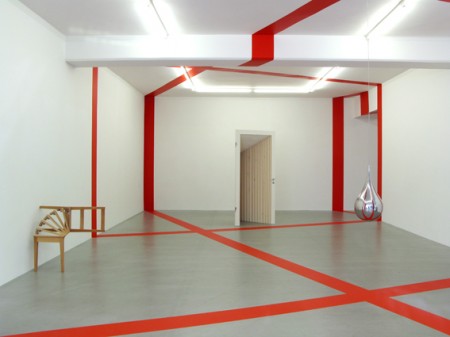 |
| Gunilla Klingberg, Parallelareal Curry Lines, 2010, image: Galerie Nordenhake |
Stockholm-based Swedish artist Gunilla Klingberg presents an installation with five accompanying art objects reminding art lovers why it remains important to personally experience art in real life. The focus of this examination is on Klingberg’s oversized display of red grid lines entitled Parallelareal Curry Lines, 2010 that make their way across Galerie Nordenhake’s floor, creeping up walls and weaving their way through the open space. Many artists possess a longstanding historical and intrinsic interest in the occult, superstition and spirituality; Klingberg’s installation consisting of these fiery markers of vinyl tape persuade the viewer to consider Manfred Curry’s mystical invention of curry lines. Once used to help decipher the world’s electromagnetic energies―both positive and negative―through dowsing, these rods were part of an effort to unleash or locate natural phenomena buried within.
One cannot help but think of the value and sheer weight that certain colors have on their viewer―in this particular case: red. A color often associated with violence, guilt, sin or anger, this primary color is also connected with love, passion and strength. The feeling that one receives when walking into Nordenhake’s space is sure to vary, yet it is probable that these axes will be disorienting, leaving a nearby occupant simultaneously charged. Red lines strategically placed on a white background may arouse curiosity and indefinite feelings of desire―even if they prove to be confusing or misdirected sentiments. Perhaps, feeling anything at all always trumps apathy. Perhaps, an adventure of mapping the un-mappable creates philosophical meaning where none resided before.
An otherwise standard white cube is transformed into segments, partitioned by the presence of these deliberate vertical and horizontal intersections. Parallelareal Curry Lines, 2010 is an inquiry into authority and its masked variants. This site-specific installation attempts to question the reasoning behind control, providing the viewer with less obvious avenues to redirect one’s life into a metaphysical direction with the assistance of the somewhat paranormal. Any attempt to usurp already established dictations is never easy, yet much can be gained from energetic transmissions associated with one’s imagination, as well as any initial attraction to the vast mysteries of the unknown.To see the review in context, click here.








